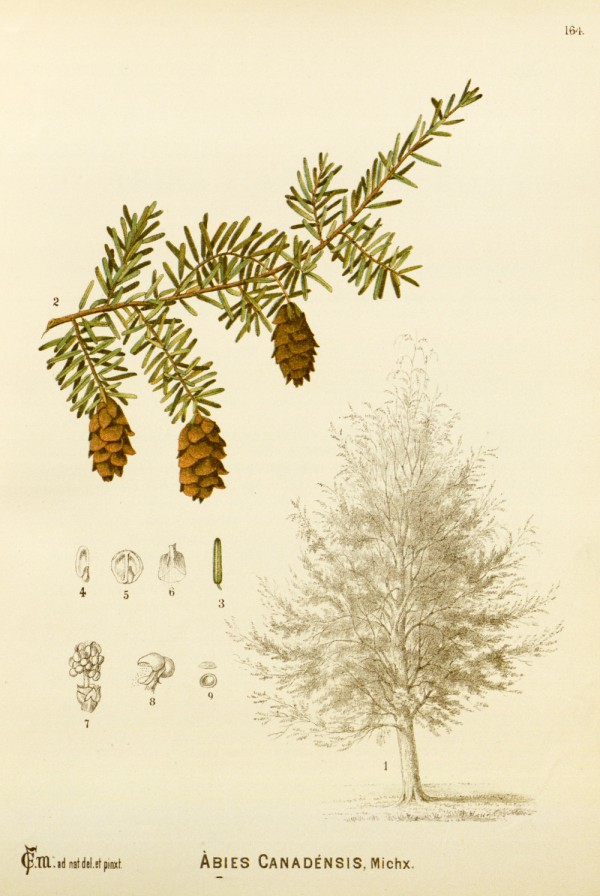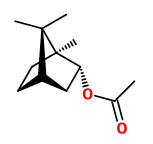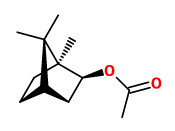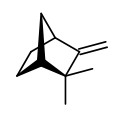Tsuga canadensis (L.) Carr. - syn.Pinus canadensis L. - Pinaceae - eastern hemlock, pruche du Canada, Kanadische Hemlockstanne, Kanadische Schierlingstanne
Tree up to 30m high, native to eastern North America. „Numerous cultivars of Tsuga canadensis have been developed, including compact shrubs, dwarfs, and graceful trees.“
http://www.efloras.org/florataxon.aspx?flora_id=1&taxon_id=233501320
„Foliage of Tsuga canadensis was distilled with steam to give a 0.249% yield of essential oil. Eleven constituents, totaling 90.6% of the original oil, were seperated by fractional distillation, and tricyclene, d-α-pinene, l-camphene, l-β-pinene, myrcene, d-α-phellandrene, l-limonene, l-thujone and l-bornyl acetate were identified.“
[The essential oil of Tsuga canadensis (L.) Carr., Shaw, A.C., Journal of the American Chemical Society, Vol.73(6), 1951, 2859-2861]
The essential leaf oil of T. canadensis was characterized by a high content of bornyl acetate (28.4%), α-pinene (20.0%) and camphene (17.5%), besides tricyclene (6.7%), myrcene (4.4%), limonene (3.0%), β-phellandrene (2.5%) and only a small amount of santene (0.15%).
[Biology and chemistry of conifer oils., Kubeczka, K.H., Schultze, W., Flavour and fragrance journal, 2(4), 1987, 137-148]
„The volatile emissions of eastern hemlock, Tsuga canadensis Carriere, were identified and quantified using standard and chiral gas chromatography and mass spectrometry. All of the identified compounds were monoterpenes, and included α-pinene, myrcene, tricyclene, camphene, α-phellandrene, β-pinene, limonene, β-phellandrene, terpinolene, and bornyl acetate. α-Pinene, myrcene, and camphene comprised greater than 75% by mass of the total release.“
[Volatile emissions of eastern hemlock, Tsuga canadensis, and the influence of hemlock woolly adelgid., Broeckling, C.D., Salom, S.M., Phytochemistry, Vol.62(2), 2003, 175-180]
„Isobornyl acetate is the predominant volatile chemical constituent of both the needle (40-45%) and leaf cushion (50-55%) in mature tissue. In spring, new growth needle tissue, isobornyl acetate levels are increased relative to old growth needle tissue while the leaf cushion tissue exhibits a depletion in isobornyl acetate compared to previous year leaf cushions.“
SPME/GC/MS analysis showed α-pinene, camphene, myrcene, β-caryophyllene and germacrene D as other main volatiles.
[Lagalante, Anthony F., et al. „Temporal and spatial variation of terpenoids in eastern hemlock (Tsuga canadensis) in relation to feeding by Adelges tsugae.“ Journal of chemical ecology 32.11 (2006): 2389-2403] https://naldc.nal.usda.gov/download/29595/PDF
„Gas chromatography/mass spectrometry (GC/MS) of Abies balsamea, Picea mariana and Tsuga canadensis leaf essential oils assigned bornyl acetate as a major peak in A.balsamea and P.mariana, while isobornyl acetate was identified as the major peak in T.canadensis. Though these two isomers elute closely on GC, their characteristic mass spectra allow unequivocal structural assignment…
Identification of the correct isomers of enzymatically produced secondary metabolites is ecologically and economically important; for instance, isobornyl acetate, correctly identified in T. canadensis and six other Tsuga species by GC/MS, may be an attractant to a major forest pest, the parasitic hemlock woolly adelgid Adelges tsugae. Conversely, bornyl acetate produced by Douglas fir (Pseudotsuga menziesii) was shown to be a feeding deterrent to another significant forest pest, the western spruce budworm, Choristoneura occidentalis.“
[Bernart, Matthew W. „Closely eluting bornyl and isobornyl acetates are chemotaxonomic markers in the Pinaceae by virtue of their unique mass spectra.“ American Journal of Essential Oils and Natural Products 4.2 (2016): 41-46] http://www.essencejournal.com/vol4/issue2/pdf/4-3-1.1.pdf

Tsuga canadensis (L.) Carrière as Abies canadensis (L.) Michx.
Millspaugh, C.F., American medicinal plants, vol. 2: t. 164 (1892)
http://plantgenera.org/species.php?id_species=1038728
Tsuga canadensis, Schlosspark Schönbrunn
© Rolf Marschner (2017),
www.botanische-spaziergaenge.at




